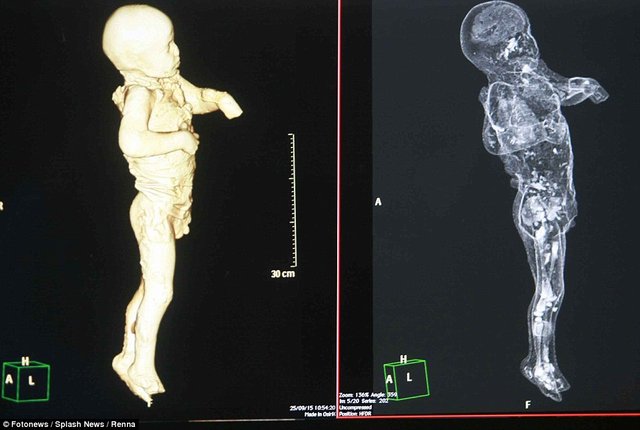Archeology Not to be Forgotten
When mummies, sarcophagus or vases pass under X-rays, surprises are not lacking. In a not so distant past, the content of mummies, pottery and other precious historical "wraps" was discovered only in one way: by uncovering them, removing the bandages, dissecting and digging inside them, neglecting the conservation aspect of the finds. Archaeologists have been spying inside sarcophagi and artifacts without damaging them, and with X-ray scans and resonances they have discovered incredible facts about their content. Here are some.
Meresamun
This singer priestess of the shrine inside the Egyptian temple of Karnak, in Thebes, was about 30 years old when she died, in 800 BC her mummy, kept in a precious sarcophagus in cartonnage (papyrus recycled and richly painted) was at the Oriental Institute of the University of Chicago since 1920, and fortunately no one, for the beauty of the envelope, had ever tried to "discard" it. This was achieved, virtually, in 2009, with a CT scan that investigated all the layers of the body, including the material inserted into the body for embalming. In practice, a complete portrait has been obtained, which includes the shape of the chin (tight), cheeks (plump), tendons and muscles. Up to the bones: the mummy still had all the teeth, including that of the judgment, and not even a caries. She suffered from hallux valgus, but apart from that and the analysis revealed nothing about the reason for death.
Sobek
It is a mummified Nile crocodile, almost 4 meters long, lived near the Ptolemaic temple of Kom Ombo, in Egypt, between 650 and 550 BC It is kept in the British Museum, and presents 25 small crocodiles modified on its back, to symbolize fertility and protection: the reptile itself was the personification of Sobek, god of the waters and floods of the Nile. The museum wanted to perform a CT scan of the exhibit, and to find a device large enough to contain the beast it was necessary to resort to that of the Equine Hospital of the Royal Veterinary College in London. It was thus discovered that the animal was mummified, exceptionally, without removing the internal organs. They found the remains of it last, bright meal: the shoulder bone and a front leg of cow, and some stones to aid digestion.
A souvenir in the skull
When the experts of the Archaeological Museum of Zagreb brought a mummy of an Egyptian woman of 2400 years ago, who owned since 1800, to do a CT scan, they did not expect to find a tool of the forgotten in her skull. The exam highlighted an elongated object placed where the brain once was. An endoscopic inspection in the nasal cavity showed that it was the tool used to remove the brain from the skull through the nose, made from a bamboo cane.
The mummy-fetus
In a cedar wood coffin just 44 cm long, found in Giza in 1907 and dated to 664-525 BC, a bundle of resin-coated bandages was found, so small that the archaeologists of the Fitzwilliam Museum in Cambridge, where it is preserved, thought he kept embalmed organs. Instead an X-ray microtomography revealed the body of the youngest mummified fetus, perhaps spontaneously aborted between the 16th and 18th weeks of gestation and then buried with all honors ( to deepen ). The child had an arm crossed over his chest, a form of burial used for the pharaohs of the New Kingdom (from 1550 BC).
The Plaster casts of Pompeii
The ashes of the eruption of Vesuvius, in 79 AD, wrapped everything, forming around the remains of houses and their inhabitants surprised by death a very resistant protective layer. Under this "crust" archaeologists working in Pompeii have found many "voids", often caused by the decomposition of organic tissues inside them. In these voids a mixture of water and plaster was poured, to preserve the shapes and obtain casts of the bodies of the ancient Pompeians. Some of the plaster casts have been subjected to TAC: what you see is the cast of the body of a 2 or 3 year old boy, found next to his mother in Pompeii. The scan revealed that the skeleton is still present inside.

La science de l'embaumement reste un secret des pharaons
Toutes nos informations sur l'embaumement et ses étapes étaient basées sur l'historien grec Hérodote, qui visita l'Egypte vers 500 av.
Ce qui est vraiment intéressant, c'est que les découvertes archéologiques récentes, faites il y a quelques années, nous fournissent des informations très importantes sur l'embaumement,
Qui est également décrit par certains comme un art de haut niveau, a été le premier médecin égyptien à étudier et développer l'anatomie dans le monde.
I have a degree in archeology and I have information about the Egyptian civilization, and I am curious to know this information to a great extent You can follow my publication
In my country there are traces of old but forgotten. keep it up
Nice post @afifa thank you
Keep sharing
good information
@afifa "it was the tool used to remove the brain from the skull" it sounds so serial killer type. I know that's probably not what they were doing but it does sound like something you see in modern thriller movies and shows where they find the body with the brain missing...and then discover the killer put the brain in the microwave as a gift for the flat mate :)
@afifa wonderful topic :)
I wait for the rest @afifa
good informations @afifa
Realy nice and informative post, thanks for it! I'm waiting for next post :)